
Concept explainers
(a)
Interpretation:
The Lewis structure of molecules or ions, spatial orientation of electron pairs and the simple geometric structure indicating the approximate bond angles of that molecules or ions should be determined.
Concept Introduction:
Lewis structure represents the valence electron arrangement around the atoms of the molecule. Lewis structure can be drawn for ionic or covalent bonds.
When predicting the geometric structure, VSPER theory is used. The three-dimensional structure of atoms in.
Answer to Problem 46CR
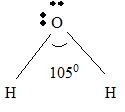
Explanation of Solution
For H2 O
Part A Step 1 →
Sum(total atoms)
Step 2 →
Pair of electrons =

Electron pairs for bonds =
Step 3 → Remaining electron pairs = 2
Part B Step 1 → Lewis structure

Step 2 → 4 electron pairs around
Step 3 → But around the
No: of bonding pairs =
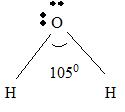
No: of non- bonding pairs =
Step 4 → Name of the structure = V-shaped or Bend.
(b)
Interpretation:
The Lewis structure of molecules or ions, spatial orientation of electron pairs and the simple geometric structure indicating the approximate bond angles of that molecules or ions should be determined.
Concept Introduction:
Lewis structure represents the valence electron arrangement around the atoms of the molecule. Lewis structure can be drawn for ionic or covalent bonds.
When predicting the geometric structure, VSPER theory is used. The three-dimensional structure of atoms in.
Answer to Problem 46CR
Explanation of Solution
For PH3 Part A Step 1 →
Sum
Step 2 → Pair of electrons =
Electron pairs for bonds =
Step 3 → Remain electron pairs =
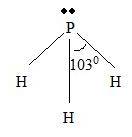
Part B Step 1 → Lewis structure
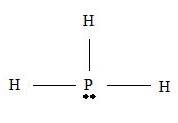
Step 2 →
Step 3 → But around the
No: of non- bonding pairs = 1
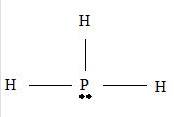
Step 4 → Name of the structure = Trigonal pyramid.
(c)
Interpretation:
The Lewis structure of molecules or ions, spatial orientation of electron pairs and the simple geometric structure indicating the approximate bond angles of that molecules or ions should be determined.
Concept Introduction:
Lewis structure represents the valence electron arrangement around the atoms of the molecule. Lewis structure can be drawn for ionic or covalent bonds.
When predicting the geometric structure, VSPER theory is used. The three-dimensional structure of atoms in.
Answer to Problem 46CR
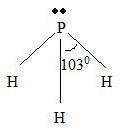
Explanation of Solution
CBr4 Part A. Step 1 →
Sum = 32
Step 2 → Pair of electrons =
Electron pairs for bonds =
Step 3 → Remain electron pairs =
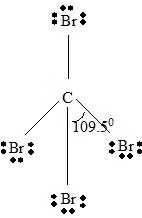
Part B Step 1 → Lewis structure
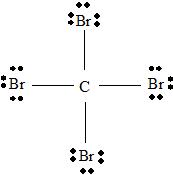
Step 2 →
Step 3 → But around the
No: of non- bonding pairs =
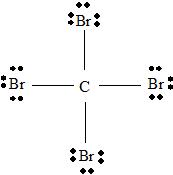
Step 4 → Name of the structure = Tetrahedral.
(d)
Interpretation:
The Lewis structure of molecules or ions, spatial orientation of electron pairs and the simple geometric structure indicating the approximate bond angles of that molecules or ions should be determined.
Concept Introduction:
Lewis structure represents the valence electron arrangement around the atoms of the molecule. Lewis structure can be drawn for ionic or covalent bonds.
When predicting the geometric structure, VSPER theory is used. The three-dimensional structure of atoms in.
Answer to Problem 46CR
Explanation of Solution
For ClO4 -
Part A. Step 1 →
Sum =
Step 2 → Pair of electrons =
Electron pairs for bonds =
Step 3 → Remain electron pairs =
Part B Step 1 → Lewis structure
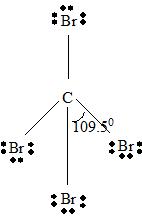
Step 2 →
Step 3 → But around the
No: of non- bonding pairs =
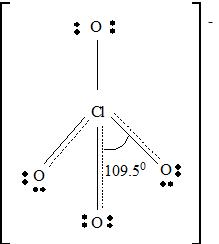
Step 4 → Name of the structure = Tetrahedral
But considering resonance, the exact position of three p bonds cannot be determined exactly. It provides a p cloud over the molecule. So that a resonance hybrid determines the exact structure of ClO4 - molecule.
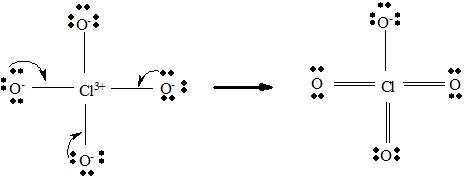
(e)
Interpretation:
The Lewis structure of molecules or ions, spatial orientation of electron pairs and the simple geometric structure indicating the approximate bond angles of that molecules or ions should be determined.
Concept Introduction:
Lewis structure represents the valence electron arrangement around the atoms of the molecule. Lewis structure can be drawn for ionic or covalent bonds.
When predicting the geometric structure, VSPER theory is used. The three-dimensional structure of atoms in.
Answer to Problem 46CR
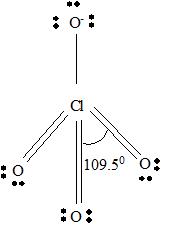
Explanation of Solution
BF3
Part A. Step 1 →
Sum =
Step 2 → Pair of electrons =
Electron pairs for bonds =
Step 3 → Remain electron pairs =
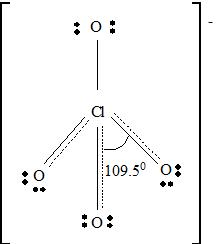
Part B Step 1 → Lewis structure
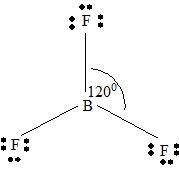
Step 2 →
Step 3 → Also around the
No: of bonding pairs =
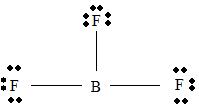
No: of non- bonding pairs =
Step 4 → Name of the structure = Trigonal planar.
(f)
Interpretation:
The Lewis structure of molecules or ions, spatial orientation of electron pairs and the simple geometric structure indicating the approximate bond angles of that molecules or ions should be determined.
Concept Introduction:
Lewis structure represents the valence electron arrangement around the atoms of the molecule. Lewis structure can be drawn for ionic or covalent bonds.
When predicting the geometric structure, VSPER theory is used. The three-dimensional structure of atoms in.
Answer to Problem 46CR
Explanation of Solution
BeF2
Part A. Step 1 →
Sum =
Step 2 → Pair of electrons =
Electron pairs for bonds =
Step 3 → Remain electron pairs =
Part B Step 1 → Lewis structure
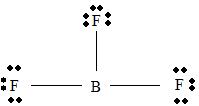
Step 2 →
Step 3 → Also around the
No: of non- bonding pairs =
Step 4 → Name of the structure = Linear
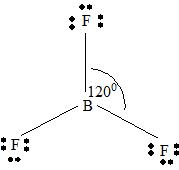 .
.
Want to see more full solutions like this?
Chapter 12 Solutions
Student Solutions Manual for Zumdahl/DeCoste's Introductory Chemistry: A Foundation, 9th
- For each reaction below, decide if the first stable organic product that forms in solution will create a new CC bond, and check the appropriate box. Next, for each reaction to which you answered "Yes" to in the table, draw this product in the drawing area below. Note for advanced students: for this problem, don't worry if you think this product will continue to react under the current conditions - just focus on the first stable product you expect to form in solution. དྲ。 ✗MgBr ? O CI Will the first product that forms in this reaction create a new C-C bond? Yes No • ? Will the first product that forms in this reaction create a new CC bond? Yes No × : ☐ Xarrow_forwardPredict the major products of this organic reaction: OH NaBH4 H ? CH3OH Note: be sure you use dash and wedge bonds when necessary, for example to distinguish between major products with different stereochemistry. Click and drag to start drawing a structure. ☐ : Sarrow_forwardPredict the major products of this organic reaction: 1. LIAIHA 2. H₂O ? Note: be sure you use dash and wedge bonds when necessary, for example to distinguish between major products with different stereochemistry. Click and drag to start drawing a structure. X : ☐arrow_forward
- For each reaction below, decide if the first stable organic product that forms in solution will create a new C - C bond, and check the appropriate box. Next, for each reaction to which you answered "Yes" to in the table, draw this product in the drawing area below. Note for advanced students: for this problem, don't worry if you think this product will continue to react under the current conditions - just focus on the first stable product you expect to form in solution. NH2 tu ? ? OH Will the first product that forms in this reaction create a new CC bond? Yes No Will the first product that forms in this reaction create a new CC bond? Yes No C $ ©arrow_forwardAs the lead product manager at OrganometALEKS Industries, you are trying to decide if the following reaction will make a molecule with a new C-C bond as its major product: 1. MgCl ? 2. H₂O* If this reaction will work, draw the major organic product or products you would expect in the drawing area below. If there's more than one major product, you can draw them in any arrangement you like. Be sure you use wedge and dash bonds if necessary, for example to distinguish between major products with different stereochemistry. If the major products of this reaction won't have a new CC bond, just check the box under the drawing area and leave it blank. Click and drag to start drawing a structure. This reaction will not make a product with a new CC bond. G marrow_forwardIncluding activity coefficients, find [Hg22+] in saturated Hg2Br2 in 0.00100 M NH4 Ksp Hg2Br2 = 5.6×10-23.arrow_forward
- give example for the following(by equation) a. Converting a water insoluble compound to a soluble one. b. Diazotization reaction form diazonium salt c. coupling reaction of a diazonium salt d. indacator properties of MO e. Diazotization ( diazonium salt of bromobenzene)arrow_forward2-Propanone and ethyllithium are mixed and subsequently acid hydrolyzed. Draw and name the structures of the products.arrow_forward(Methanesulfinyl)methane is reacted with NaH, and then with acetophenone. Draw and name the structures of the products.arrow_forward
- 3-Oxo-butanenitrile and (E)-2-butenal are mixed with sodium ethoxide in ethanol. Draw and name the structures of the products.arrow_forwardWhat is the reason of the following(use equations if possible) a.) In MO preperation through diazotization: Addition of sodium nitrite in acidfied solution in order to form diazonium salt b.) in MO experiment: addition of sodium hydroxide solution in the last step to isolate the product MO. What is the color of MO at low pH c.) In MO experiment: addition of sodium hydroxide solution in the last step to isolate the product MO. What is the color of MO at pH 4.5 d.) Avoiding not cooling down the reaction mixture when preparing the diazonium salt e.) Cbvcarrow_forwardA 0.552-g sample of an unknown acid was dissolved in water to a total volume of 20.0 mL. This sample was titrated with 0.1103 M KOH. The equivalence point occurred at 29.42 mL base added. The pH of the solution at 10.0 mL base added was 3.72. Determine the molar mass of the acid. Determine the Ka of the acid.arrow_forward
 Chemistry by OpenStax (2015-05-04)ChemistryISBN:9781938168390Author:Klaus Theopold, Richard H Langley, Paul Flowers, William R. Robinson, Mark BlaserPublisher:OpenStax
Chemistry by OpenStax (2015-05-04)ChemistryISBN:9781938168390Author:Klaus Theopold, Richard H Langley, Paul Flowers, William R. Robinson, Mark BlaserPublisher:OpenStax Chemistry & Chemical ReactivityChemistryISBN:9781133949640Author:John C. Kotz, Paul M. Treichel, John Townsend, David TreichelPublisher:Cengage Learning
Chemistry & Chemical ReactivityChemistryISBN:9781133949640Author:John C. Kotz, Paul M. Treichel, John Townsend, David TreichelPublisher:Cengage Learning Chemistry & Chemical ReactivityChemistryISBN:9781337399074Author:John C. Kotz, Paul M. Treichel, John Townsend, David TreichelPublisher:Cengage Learning
Chemistry & Chemical ReactivityChemistryISBN:9781337399074Author:John C. Kotz, Paul M. Treichel, John Townsend, David TreichelPublisher:Cengage Learning
 ChemistryChemistryISBN:9781305957404Author:Steven S. Zumdahl, Susan A. Zumdahl, Donald J. DeCostePublisher:Cengage Learning
ChemistryChemistryISBN:9781305957404Author:Steven S. Zumdahl, Susan A. Zumdahl, Donald J. DeCostePublisher:Cengage Learning Chemistry: An Atoms First ApproachChemistryISBN:9781305079243Author:Steven S. Zumdahl, Susan A. ZumdahlPublisher:Cengage Learning
Chemistry: An Atoms First ApproachChemistryISBN:9781305079243Author:Steven S. Zumdahl, Susan A. ZumdahlPublisher:Cengage Learning





